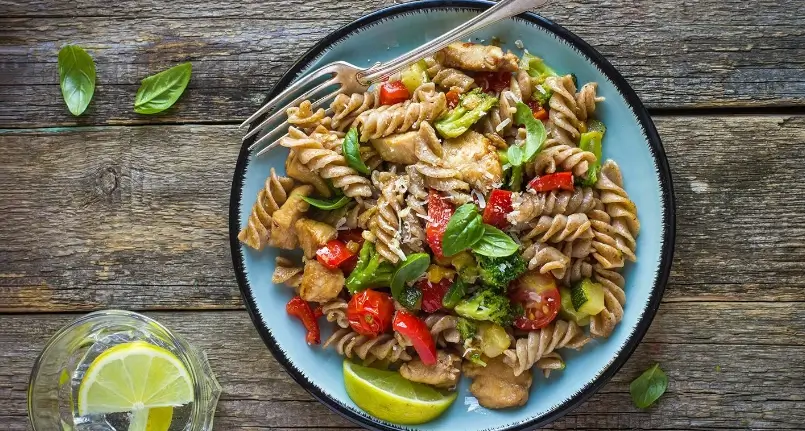Pasta Food
Pasta is a typical Italian product ; it is a food made up of cereal -based flours , water and possibly other ingredients ( eggs , fillings, etc.); the production of pasta is carried out through: mixing and processing, fragmentation and shaping, possible drying . Its nutritional composition is characterized by:
- High energy intake
- High intake of complex carbohydrates
Pasta can be dry (75% of total national consumption) or fresh (25%); the dry one must be composed exclusively of semolina or durum wheat semolina , while the fresh one or with egg (having higher acidity and humidity) can contain up to 3% of soft wheat flour . Industrial pasta (as opposed to artisanal pasta) is made up exclusively of durum wheat mixed with water, while the addition of other ingredients requires classification in the category of special pastas (with egg [further regulated], with squid ink , pastes
dietary, etc.).
Diabetics
All people with type 1 , type 2 and gestational diabetes mellitus are diabetic .
Type 1 diabetics have little or no insulin production which requires exogenous injection at the end of each meal; it is a disease with autoimmune or idiopathic etiology, or caused by severe pancreatitis , but in any case irreversible. The insulin dose is estimated on the basis of the quantity and quality of the meal: the higher the glycemic load (quantity and quality of carbohydrates in the meal) corresponds to the need for higher insulin doses.
The type 2 diabetic, on the other hand, suffers from chronic hyperglycemia caused by poor peripheral sensitivity to insulin (with hyperinsulinemia = overweight ), consequently (in the long term) develops a reduction in pancreatic secretion up to definitive insufficiency; it is a disease with multiple etiology , which recognizes risk factors such as genetic predispositions, nutritional imbalance with excess sugar , overweight or obesity, sedentary lifestyle , etc.
Type 2 diabetics are treated pharmacologically with hypoglycaemic drugs and more rarely require a post-prandial injection of insulin.
The gestational diabetic (pregnant female), presents a picture similar to the type 2 diabetic; if untreated, pregnancy diabetes can compromise the development of the unborn child (see macrosomal child ) and persist even after delivery .
The diabetic, whatever he is, must keep his blood sugar and insulin levels under control.
Certainly, nutrition plays an essential role, especially in disorders characterized by peripheral resistance (type 2 and gestational); in this case, an excess of calories and above all of carbohydrates , associated with overweight or obesity, as well as representing an etiological cause of diabetes can determine its ingravescence by predisposing the subject to: neuropathies, complications of the micro and macrocirculation, cataracts , dyslipidemias.. atherogenesis , metabolic syndrome , myocardial infarction , stroke , and death.
Essential lifestyle interventions for diabetics (especially those at risk of complications) are:
- Increased physical and sporting activity
- Calorie moderation
- Reduction of overweight
- Reduction of carbohydrates , especially simple ones
- Reduction of sodium , cholesterol and saturated fat
- Percentage (and not quantitative!) increase in unsaturated fats and low glycemic index carbohydrates
- Increase in dietary fiber , essential fats , antioxidants , lecithins, phytosterols and other useful molecules present in food .
What is Pasta for Diabetics?
Pasta for diabetics is a special pasta and specifically a dietetic food .
Pasta for diabetics was created with the aim of compensating for the two negative characteristics that make pasta (as well as bread , polenta and all refined cereals) an inadvisable product in case of diabetes mellitus :
- High glycemic load
- High glycemic index
N.B. _ It should be emphasized that, more than the simple use, the diabetic frequently manifests a real abuse of pasta, which is why (often) – although the consumption of the food is allowed in due moderation – it is easier to eliminate it from the diet rather than reduce it.
Pasta for diabetics differs from the traditional one in:
- Lower glycemic load – 58g VS 82.8g of traditional pasta
- Lower Glycemic Index – 23 GI VS >50 GI of traditional pasta
- Lower energy intake – 283 kcal VS 356 kcal of traditional pasta
- More dietary fiber – 15g VS 2.6g of traditional pasta
In theory, in addition to guaranteeing a better metabolic impact, pasta for diabetics should allow the optimization of slimming therapy , provided that it is inserted in a balanced/low-calorie nutritional context associated with constant and regular physical exercise ; in the light of these beneficial properties, the pasta for diabetics obtained a Decree of the Ministry of Health for the nutrition of diabetics (n.600.12/8114 of 10/12/2001).
How does Diabetic Paste work?
Pasta for diabetics, compared to traditional pasta and if used properly, has glycemic moderation effects and weight loss.
How is it possible?
It’s actually very simple; being a special pasta, pasta for diabetics can make use of the addition of one or more ingredients which, if they are able to counteract a specific pathology, attribute dietary properties to the food (see dietetic foods ). In short, the magic ingredient is one and only one… fiber.
The reader could also reiterate… wholemeal pasta also contains more fiber than normal, does this mean that it has the same therapeutic effects?… unfortunately not!
The dietary fiber added to pasta for diabetics is inulin , a soluble compound (and not insoluble likewheat bran ) which, in addition to being quantitatively 50% higher than wholemeal bran and 600% higher than white bran, modulates intestinal transit in a decidedly effective way. Pasta for diabetics is
nothing but: pasta with added inulin, a dietary fiber typically found in vegetables and fruit .
And here is the video recipe for preparing pasta for diabetics at home , with inulin, wholemeal flour and soy lecithin .




